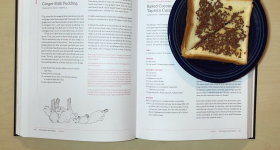The curvature of a fortune cookie may bring to mind China and Chineseness, but in reality it’s an iconic shape largely for Americans who can’t seem to get enough of them.
There are wedding fortune cookies, Valentine’s Day fortune cookies, chocolate-dipped fortune cookies, fortune cookie baby booties, fortune cookie vanity soaps, fortune cookie diamond jewelry — even dog fortune cookies.
Americans are often surprised to learn that the cookies are relatively unknown in China, where as an experiment, I handed out fortune cookies to passers-by to get their reactions.
Instinctively, they put the cookies whole in their mouths (you almost want to stop them). Once they crunch into them, they’re puzzled to discover the paper fortune sometimes lodged in their teeth. “Americans are so strange,” they say. “Why are they putting pieces of paper in their cookies?”
Their reactions are no surprise since fortune cookies actually originate from Japan, where there are still small family-run bakeries in Kyoto that make the cookies by hand. Flavored with sesame and miso, they are bigger and browner than their American cousins. Fortune cookies were brought over to America by Japanese immigrants. They became popular shortly after World War II as they spread in Chinese restaurants.
Fortune cookies: invented by the Japanese, popularized by the Chinese and digested by Americans.
Jennifer 8. Lee is the author of The Fortune Cookie Chronicles (2008) and a former reporter for The New Times.
See the winning and runner-up photos from Hyphen's Fortune Cookie Photo Contest.
Accompany Hyphen inside San Francisco's Golden Gate Fortune Cookie Factory.









Comments